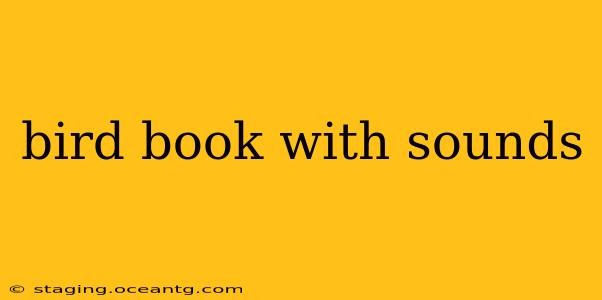For bird enthusiasts of all levels, the joy of birdwatching is greatly enhanced by identifying their songs and calls. A bird book with sounds offers an unparalleled immersive experience, bringing the beauty of avian vocalizations directly to your fingertips. But with so many options available, choosing the right one can feel overwhelming. This comprehensive guide will help you navigate the world of bird books with sounds, ensuring you find the perfect companion for your next birding adventure.
What to Look for in a Bird Book with Sounds
Before diving into specific recommendations, let's consider the key features to look for in a high-quality bird book with sounds:
- Geographic Coverage: Does the book cover your region's bird species? A book focused on North American birds won't be helpful if you're birding in Europe.
- Sound Quality: High-fidelity recordings are crucial. Look for reviews mentioning clear, accurate, and natural-sounding bird vocalizations. Poor sound quality can be frustrating and hinder identification.
- Ease of Use: A well-designed book should make finding bird information and accessing sounds intuitive. Consider features like an alphabetical index, detailed illustrations, and easy-to-navigate sound playback mechanisms (e.g., QR codes, a downloadable app).
- Species Coverage: How many species are included? A comprehensive guide will cover a broader range of birds, increasing your chances of identifying any bird you encounter.
- Additional Features: Some books include range maps, detailed descriptions of bird behavior, and conservation status information, enhancing the overall learning experience.
What are the different types of bird books with sounds?
Traditional Books with CDs: These are often more affordable and offer a familiar format, however, the CD may be easily lost or damaged.
Books with QR Codes: These books use QR codes that link to online audio files or apps, providing a more convenient and readily accessible experience. The downside is reliance on internet access.
Apps Only: Dedicated bird identification apps offer vast sound libraries and often include other useful features like image galleries, range maps, and community-based sightings. The downside is requiring a device capable of running the app.
H2: How do I use a bird book with sounds effectively?
Effectively using a bird book with sounds requires a strategic approach. First, try to visually identify the bird as much as possible. Then, locate the bird in your book using its visual description and illustrations. Finally, listen to the recordings, comparing the sounds you heard in the field with those in the book.
H2: What are some good bird books with sounds for beginners?
Many excellent beginner-friendly options are available. Look for books with clear illustrations, concise descriptions, and a focus on common species in your area. Many publishers offer regional guides specifically catering to different geographical locations.
H2: Are there bird books with sounds for specific regions?
Absolutely! Many publishers specialize in regional bird guides. Searching for "[your region] bird guide with sounds" will yield specific results. National Audubon Society, Sibley, and Peterson are good starting points for publishers who offer regional guides.
H2: What if my bird book doesn't include the bird I heard?
If your bird book doesn't contain the bird you heard, consider using online resources like xeno-canto.org (a large database of bird sounds) or contacting local birdwatching clubs or experts for assistance.
H2: Can I use a bird book with sounds for learning bird songs by ear?
Yes! Repeatedly listening to the recordings in your bird book will help you learn to recognize the songs and calls of different species. Try focusing on distinctive features, like pitch, rhythm, and the bird's overall vocalization patterns.
Choosing the right bird book with sounds can significantly improve your birdwatching experience. By considering the factors outlined above and exploring different options, you’ll find the perfect companion to help you identify, appreciate, and better understand the amazing world of birds. Remember to always be respectful of birds and their natural habitats while enjoying the beauty of their songs and calls.
